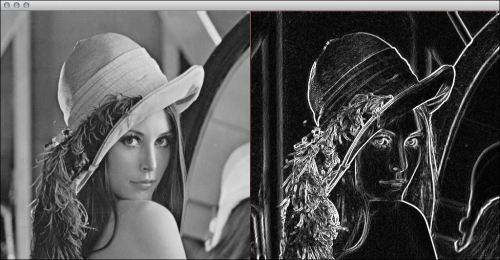In this recipe, we will demonstrate how to use edge detection function, which is one of the image processing functions implemented directly in Cinder.
Make sure you have Xcode up and running with an empty Cinder project opened. We will need a sample image to proceed, so save it in your assets folder as image.png.
We will process the sample image with the edge detection function. Perform the following steps to do so:
- Include necessary headers:
#include "cinder/gl/Texture.h" #include "cinder/Surface.h" #include "cinder/ImageIo.h" #include "cinder/ip/EdgeDetect.h" #include "cinder/ip/Grayscale.h"
- Add two properties to your main class:
Surface8u mImageOutput;
- Load the source image and set up
Surfacefor processed images inside thesetupmethod:mImage = loadImage( loadAsset("image.png") ); mImageOutput = Surface8u(mImage.getWidth(), mImage.getHeight(), false); - Use image processing functions:
ip::grayscale(mImage, &mImage); ip::edgeDetectSobel(mImage, &mImageOutput);
- Inside the
drawmethod add the following two lines of code for drawing images:gl::draw(mImage); gl::draw(mImageOutput, Vec2f(512.f+1.f, 0.f));
As you can see, detecting edges in Cinder is pretty easy because of implementation of basic image processing functions directly in Cinder, so you don't have to include any third-party libraries. In this case we are using the grayscale function to convert the original image color space to grayscale. It is a commonly used feature in image processing because many algorithms work more efficiently on grayscale images or are even designed to work only with grayscale source images. The edge detection is implemented with the edgeDetectSobel function and uses the Sobel algorithm. In this case, the first parameter is the source original grayscale image and the second parameter, is the output Surface object in which the result will be stored.
Inside the draw method we are drawing both images, as shown in the following screenshot:

You may find the image processing functions implemented in Cinder insufficient, so you can also include to your project, third-party library such as OpenCV. We explained how we can use Cinder and OpenCV together in the preceding recipe, Integrating with OpenCV.
Other useful functions in the context of edge detection are Canny and findContours. The following is the example of how we can use them:
vector<vector<cv::Point> > contours; cv::Mat inputMat( toOcv( frame ) ); // blur cv::cvtColor( inputMat, inputMat, CV_BGR2GRAY ); cv::Mat blurMat; cv::medianBlur(inputMat, blurMat, 11); // threshold cv::Mat thresholdMat; cv::threshold(blurMat, thresholdMat, 50, 255, CV_8U ); // erode cv::Mat erodeMat; cv::erode(thresholdMat, erodeMat, 11); // Detect edges cv::Mat cannyMat; int thresh = 100; cv::Canny(erodeMat, cannyMat, thresh, thresh*2, 3 ); // Find contours cv::findContours(cannyMat, contours, CV_RETR_TREE, CV_CHAIN_APPROX_SIMPLE);
After executing the preceding code, the points, which form the contours are stored in the contours variable.
